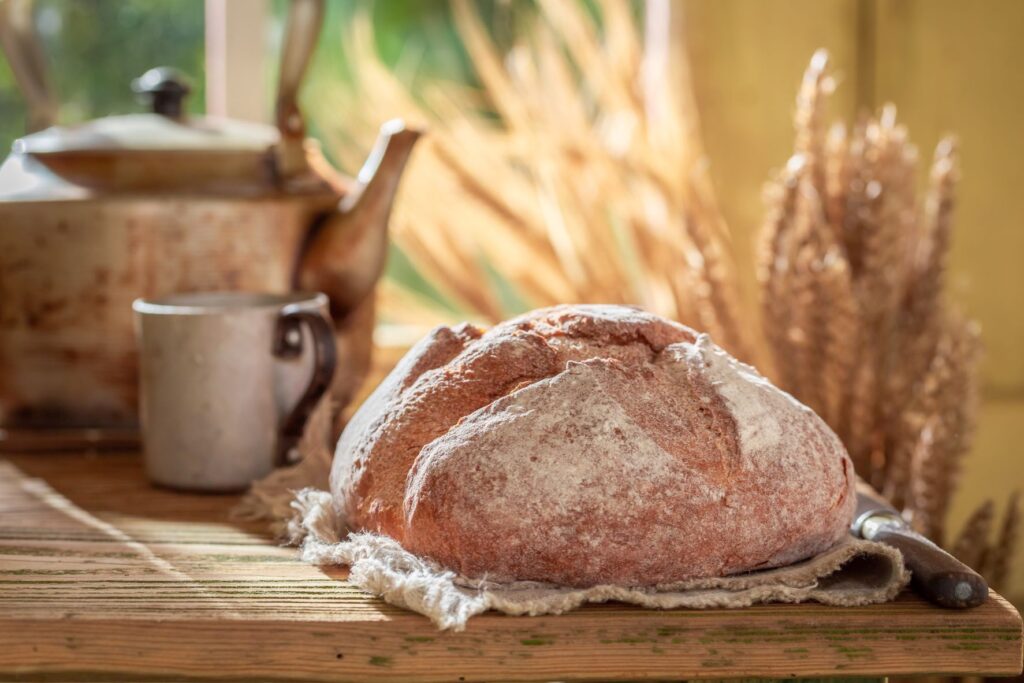
Being there from grain to bread is what makes the difference. It is a real, traditional art of baking that anyone can learn.
The industrial preservation of flour as well as milk destroys the wholesome natural product. In this process, not only important nutrients die, but also the enzymes. Whether wholemeal flour or white flour, both are industrially preserved and thus lose their nutrients. In order to be allowed to declare a whole grain flour as “whole grain-, the germ is first removed, heated (i.e. inactivated) and then added back to the flour The lower the flour type, the more bran (husk) has been removed. A flour sifted by hand corresponds to a medium flour type depending on the sieve of a flour type from 700 to 1050). Commercially available white flour in flour type 405 can only be produced by industrial means. The lower the type designation, the more heavily commercial flour was sifted.
Egyptian tomb paintings show the processing of grain, where after grinding was sifted up to 13 times. This method of production testified to prosperity and wealth, because the general people and slaves ate wholemeal breads. But interestingly, X-rays of mummies show that half of the Egyptians, pharaohs and princesses living in splendor were very ill. You must have suffered from arthritis or arteriosclerosis, among other things, when you were alive. Also the fine rich society of Central Europe began at some point to sift their cereals and thus produce a sweeter, lighter and lighter dough, but they did not do anything good for your health.
The researchers Kühnau and Bernasek were able to determine in animal feeding experiments that the fertility of rats became increasingly worse over the generations if they were fed (in addition to 50% normal food) with stored flour or extract flours. In the fourth generation they even died out. A high fertility rate was retained exclusively by the animals fed with freshly ground flour. If the animals were fed exclusively with white flour, they even died within a few weeks. It becomes clear that white flour has lost the ability to nourish us.
Even whole grain products from the supermarket are usually NOT! made from freshly milled grain and contain more additives than must be declared on the packaging. The fact is, however, that the industry must always deliver a consistent result, but the natural product grain cannot promise such a result. This is because the perfect baking properties of ready-made bakery products and extraction flours come from the industry’s bag of tricks. At the same time, we wonder why more and more people are getting problems with and from these products. Gluten is also a problem because it is often even added, in the form of isolated“gluten powder” (declared as wheat protein or wheat gluten). The more gluten, the more elastic the dough and the more perfect the baking result. The customer is happy, at least in the first moment. You will be surprised, because a real whole wheat roll will never be as huge and at the same time light as a roll made from “improved” extraction flours. In order to keep each batch of packaged flours the same, non-declared flour improvers such as enzymes and ascorbic acid are often used.
With a focus on gut and dental health, we started our research with the book “Curing Caries” by Ramiel Nagel, which is largely based on the findings of Weston Price. studies. Price developed a program to cure tooth decay in which he recommended making sourdough breads from freshly ground whole grains. Ramiel Nagel, however, disagrees with Prlce on the subject of grains. According to “recent’ findings, he sees whole grain products as a threat to intestinal and dental health. Since not only most of the nutrients but also the anti-nutrients are in the husk, he advises against whole grains, especially in cases of caries, and recommends using a medium flour type, i.e., sifting the grain. “If Dr. Prlce had had this knowledge in his time, his program would probably have been even more effective,” he says in his book. Interestingly, the Weston Prlce Foundation has not deleted these supposedly new findings from its still-current dietary recommendations. For example, it states “Use only whole grains, legumes and nuts that have been properly prepared by soaking, sprouting and leavening.” White flour products and white rice are also discouraged.
We need to get back to the roots of our ancestors and not only bake our own bread, but also freshly grind the grain.
Prepared according to ancient traditional craftsmanship, whole grain products are not only original, but also healthy.
A milled flour from the whole grain, carefully prepared, does not harm the intestine, nor the formation of teeth. Therefore, we have now decided (although not from the beginning) to work with freshly milled grain and mainly the whole grain. We believe that the path that the healthy traditional peoples also took is the healthiest and most proven.
Address:
Gasteigweg 25,
5400 Hallein
Austria
Opening hours:
Monday to Thursday: 09 – 16:00
Friday: 09 – 12:00
Contact:
Phone: +43 6245 83282
E-mail: info@agrisan.at
Address:
Gasteigweg 25,
5400 Hallein
Austria
Opening hours:
Monday to Thursday: 09 – 16:00
Friday: 09 – 12:00
Contact:
Phone: +43 6245 83282
E-mail: info@agrisan.at

